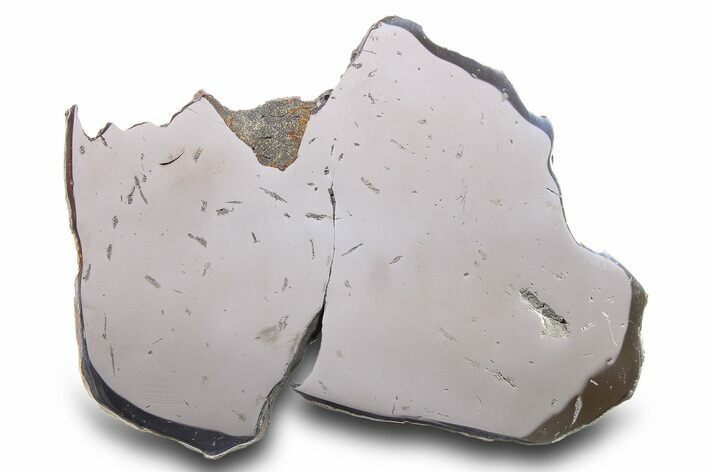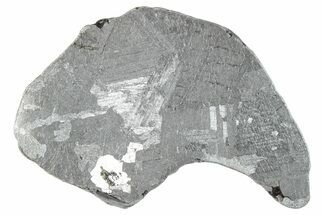5.51" Gebel Kamil Iron Meteorite Slice (210.4 g) - Egypt
This is a 5.51" wide (210.4 gram) slice of the famous Gebel Kamil iron meteorite. It has been cut flat and polished to a mirror finish on both sides.
Comes with an acrylic display stand.
Comes with an acrylic display stand.
The Gebel Kamil Meteorite
In 2009 a 150-foot meteorite impact crater was identified in the East Uweinat Desert of Egypt, near the southern border with Sudan. Soviet topographic maps dating to the 1980s made note of the structure, where it was listed as a source of iron, but no one had concluded it to be from a meteorite.
This impact is estimated to have occurred within the last 5,000 years. Thousands of pieces of meteorite shrapnel were collected in the crater and surrounding desert up to a kilometer away. This shrapnel was caused by the meteorite being torn apart on impact. These pieces are generally well-preserved with minimal weathering, ranging from a few grams to tens of kilograms. Due to this level of preservation and weathering, many meteorite experts believe the impact might be more recent than 5,000 years ago.
Meteoritical Bulletin: Entry for the Gebel Kamil Meteorite
In 2009 a 150-foot meteorite impact crater was identified in the East Uweinat Desert of Egypt, near the southern border with Sudan. Soviet topographic maps dating to the 1980s made note of the structure, where it was listed as a source of iron, but no one had concluded it to be from a meteorite.
This impact is estimated to have occurred within the last 5,000 years. Thousands of pieces of meteorite shrapnel were collected in the crater and surrounding desert up to a kilometer away. This shrapnel was caused by the meteorite being torn apart on impact. These pieces are generally well-preserved with minimal weathering, ranging from a few grams to tens of kilograms. Due to this level of preservation and weathering, many meteorite experts believe the impact might be more recent than 5,000 years ago.
Meteoritical Bulletin: Entry for the Gebel Kamil Meteorite
About Iron Meteorites
Iron type meteorites are composed primarily of iron and nickel, and are the remnants of differential cores torn apart at the beginning of the solar system. These metallic meteorites are often the easiest to identify after millions of years post-impact because they are quite different from terrestrial material, especially when it comes to their mass-to-surface area ratio. They are exceptionally heavy for their size since iron is a high-density metal: this is also why the Earth's core is nickel-iron. As planets form, the densest metals form gravitational centers, bringing more and more material into their gravitational pull. In the solar system's rocky planets, these dense materials are most often nickel and iron.
Most iron meteorites have distinctive, geometric patterns called Widmanstätten patterns, which become visible when the meteorite is cut and acid etched. These patterns are criss-crossing bands of the iron-nickel alloys kamacite and taenite that slowly crystalized as the core of the meteorites' parent bodies slowly cooled. Such large alloy crystallizations for mover millions of years and do not occur naturally on Earth, further proving that iron meteorites come from extraterrestrial bodies.
Iron type meteorites are composed primarily of iron and nickel, and are the remnants of differential cores torn apart at the beginning of the solar system. These metallic meteorites are often the easiest to identify after millions of years post-impact because they are quite different from terrestrial material, especially when it comes to their mass-to-surface area ratio. They are exceptionally heavy for their size since iron is a high-density metal: this is also why the Earth's core is nickel-iron. As planets form, the densest metals form gravitational centers, bringing more and more material into their gravitational pull. In the solar system's rocky planets, these dense materials are most often nickel and iron.
Most iron meteorites have distinctive, geometric patterns called Widmanstätten patterns, which become visible when the meteorite is cut and acid etched. These patterns are criss-crossing bands of the iron-nickel alloys kamacite and taenite that slowly crystalized as the core of the meteorites' parent bodies slowly cooled. Such large alloy crystallizations for mover millions of years and do not occur naturally on Earth, further proving that iron meteorites come from extraterrestrial bodies.
TYPE
Iron (Ungrouped)
LOCATION
East Uweinat Desert, Egypt
SIZE
5.51 x 4.01", .1" thick, Weight: 210.4 grams
CATEGORY
SUB CATEGORY
ITEM
#284538
 Reviews
Reviews










